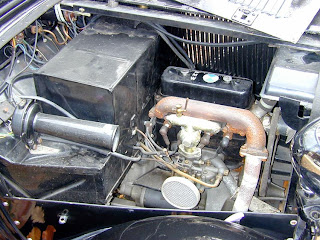BMW 3/20
|
Manufacturer
|
BMW
|
|
Also called
|
AM-1, AM-2, AM-3, AM-4
|
|
Production
|
1932 – 1934
|
|
Assembly
|
Eisenach, Germany
|
|
Predecessor
|
BMW 3/15
|
|
Successor
|
BMW 309
|
|
Class
|
City car
|
|
Body style
|
four seat saloon
four seat cabriolet
two seat convertible coupé
|
|
Layout
|
FR layout
|
|
Engine
|
788 cc (48.1 cu in) OHV straight-4
|
|
Transmission
|
4-speed manual
|
|
Wheelbase
|
2,150 mm (84.6 in)
|
|
Length
|
3,200 mm (126 in)
|
|
Width
|
1,420 mm (56 in)
|
|
Height
|
1,550 mm (61 in)
|
|
Curb weight
|
650 kg (1,433 lb) with saloon body
|
|
Designer(s)
|
Alfred Böning
|
 |
| BMW 3/20 AM 4 engine |
The 3/20 was larger than the 3/15, with an 84.6 in (2,149 mm) wheelbase and a body 3 in (76 mm) lower than the 3/15. The 3/20 used a backbone frame unrelated to the 3/15's Austin Seven "A" frame. It inherited the 3/15 DA-4's independent front suspension and added a swing axleindependent rear suspension, using a transverse leaf spring similar to that used at the front. The standard bodies for the car were built by Daimler-Benz in Sindelfingen.
Journalist and engineer Josef Ganz, who had criticized the 3/15 DA-4's suspension system in the magazine Motor-Kritik, was contracted in July 1931 as a consultant in the design of the 3/20 AM-1.
Four versions of the 3/20 were built: AM 1, AM 2, AM 3 and AM 4, where AM denoted Automobil München.
Journalist and engineer Josef Ganz, who had criticized the 3/15 DA-4's suspension system in the magazine Motor-Kritik, was contracted in July 1931 as a consultant in the design of the 3/20 AM-1.
Four versions of the 3/20 were built: AM 1, AM 2, AM 3 and AM 4, where AM denoted Automobil München.











0 comments: